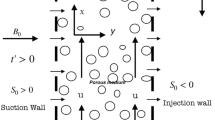Abstract
This paper presents numerical simulation of the physical phenomena in heat pipe. The vapour dynamics of working fluid is considered in the numerical analysis of the heat pipe. A two-phase analysis is carried out for the heat pipe. The compressible flow equations for vapour-phase interaction with water particle phase are solved by a finite volume technique. A three stage Runge-Kutta time-stepping method is employed to solve vapour dynamics. Damping term is added to stablize the numerical scheme. An example is worked out to study the two phase flow in the heat pipe.
Zusammenfassung
Die Arbeit bezieht sich auf die numerische Simulation der physikalischen Phänomene in Wärmerohren, wobei insbesondere die Verdampfungsdynamik des Arbeitsmediums in einer Zweiphasen-Analyse untersucht wird. Mit Hilfe eines zeitabhängigen Differenzenverfahrens lassen sich die, die Wechselwirkung zwischen Dampfphase und Wasserpartikeln beschreibenden Gleichungen für den kompressiblen Fall lösen. Mittels eines dreistufigen Runge/Kutta-Verfahrens wird die Dampfdynamik analysiert, wobei durch Einführung eines Dämpfungsterms eine Stabilisierung des numerischen Verfahrens bewirkt wird. Ein praktisches Berechnungsbeispiel schließt die Untersuchung ab.
Similar content being viewed by others
Abbreviations
- C v :
-
specific heat at constant volume
- D 0 :
-
outer diameter of heat pipe
- D i :
-
inner diameter of heat pipe
- e :
-
total energy
- f :
-
friction coefficient
- h :
-
convective heat transfer coefficient
- h fg :
-
latent heat of vaporisation
- K :
-
thermal conductivity
- l c :
-
length of condenser
- p :
-
pressure
- q :
-
energy flux
- r :
-
vapour space radius
- Re :
-
Reynolds number
- T :
-
temperature
- U,F,H :
-
vectors in vapour formulation
- u :
-
vapour velocity
- x :
-
axial coordinate
- μ :
-
vapour viscosity
- ρ :
-
vapour density
- ω w :
-
shear stress
References
Beam, J.E.: Transient heat pipe analysis. AIAA paper 85-0936, AIAA 20th Thermophysics Conf. (1985)
Bowman, J.; Sweeten, R.W.: Numerical heat pipe modelling. AIAA paper 89-1705 (1989)
Brown, J.E.;Winn, R.C.;Martin, H.L.: Transient heat pipe modelling, A quasisteady, incompressible vapour model. J. Thermophys. Heat Transfer 6 (1992) 571–574
Hatta, N.;Fujimoto, H.;Takuda, H.: Numerical analysis of flow pattern of impinging liquid sprays in a cold model for cooling a hot flat plate. Appl. Sci. Res. 50 (1983) 129–147
Jameson, A.; Schmidt, W.; Turkel, E.: Numerical solution of the Euler equations by finite volume methods using Runge-Kutta time stepping schemes. AIAA paper 81-1259 (1981)
Dunn, P.D.;Reay, D.A.: Heat Pipes. Pergmon Press, N.Y. (1976)
Author information
Authors and Affiliations
Rights and permissions
About this article
Cite this article
Mehta, R.C., Jayachandran, T. Numerical analysis of transient two phase flow in heat pipe. Heat and Mass Transfer 31, 383–386 (1996). https://doi.org/10.1007/BF02172583
Received:
Issue Date:
DOI: https://doi.org/10.1007/BF02172583




